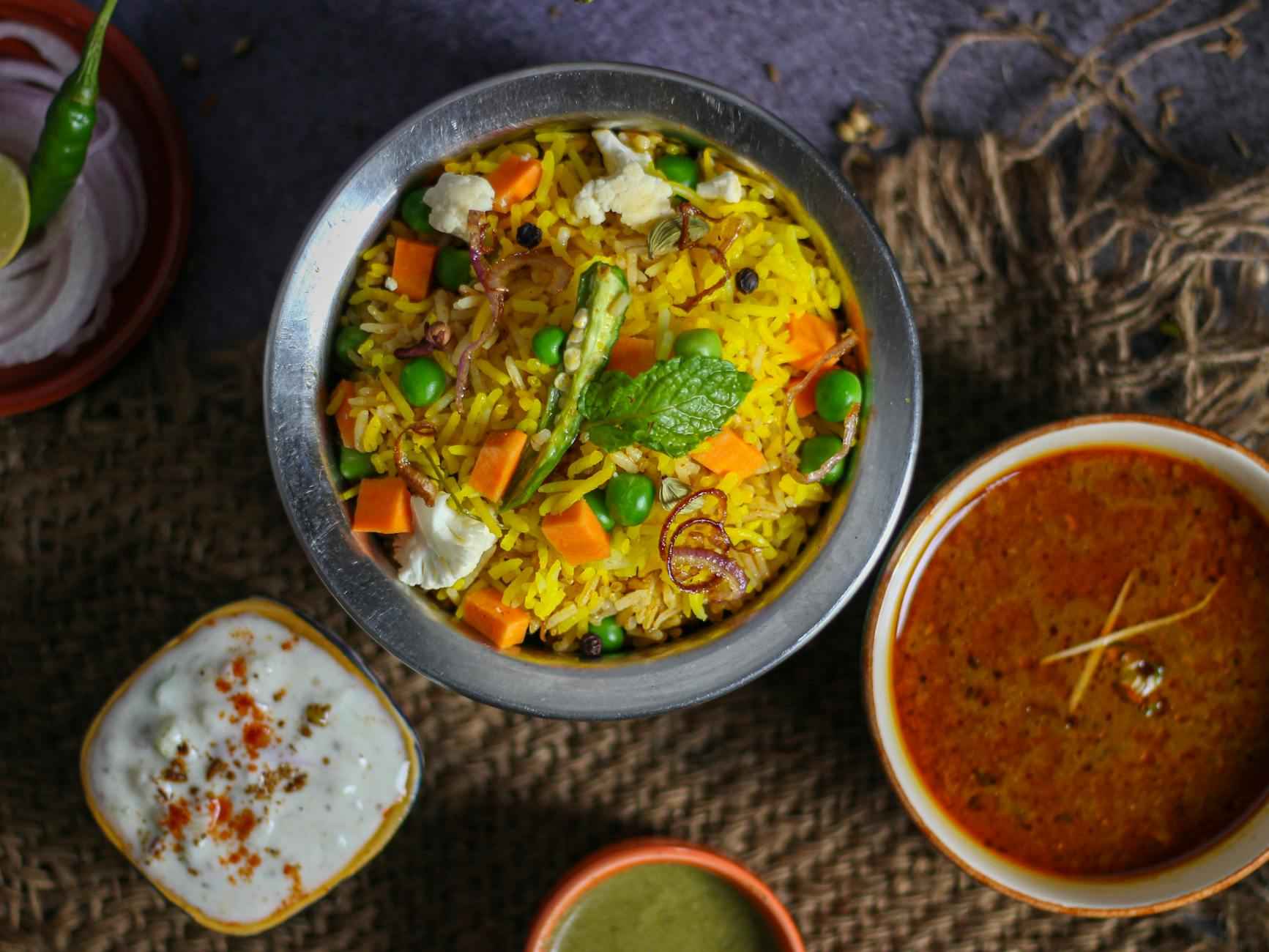This article explores the diverse range of Indian rice dishes popular in New York, highlighting their origins, flavors, and the best places to enjoy them.
Indian cuisine is renowned for its rich flavors and diverse dishes, with rice being a staple ingredient. In New York, the culinary landscape is a melting pot that showcases various Indian rice dishes, each with its own unique history and flavor profile. From the aromatic biryanis to comforting khichdi, this article delves into the most loved Indian rice dishes in the city, their origins, and where to find them.
What is Biryani? A Deep Dive into its Origins
Biryani is not just a dish; it’s an experience that encapsulates the essence of Indian culinary traditions. Originating from the Persian word ‘birinj,’ meaning rice, biryani is believed to have been brought to India by the Mughals. Over the centuries, it has evolved into various regional styles, each reflecting local ingredients and cooking techniques. The dish typically consists of marinated meat or vegetables layered with fragrant basmati rice, cooked together to allow the flavors to meld beautifully. Its cultural significance is immense, often served during celebrations and gatherings, making it a symbol of hospitality and richness in Indian culture.
Popular Variants of Biryani in New York
New York’s Indian restaurants offer a stunning variety of biryani styles, catering to the diverse tastes of its residents. Among the most popular variants are:
- Hyderabadi Biryani: Known for its spicy and aromatic profile, this variant is a must-try. It often features succulent pieces of marinated meat, layered with saffron-infused rice.
- Lucknowi Biryani: Also referred to as Awadhi biryani, it is characterized by its subtle flavors and royal heritage, often cooked using the dum method.
- Kolkata Biryani: Unique for its inclusion of potatoes and boiled eggs, this style reflects the culinary influences of Bengal, offering a slightly sweet twist.
Hyderabadi Biryani: A Spicy Delight
Hyderabadi biryani stands out for its bold flavors and intricate preparation. It is traditionally made with marinated meat (usually chicken or lamb), layered with basmati rice and cooked in a sealed pot over low heat, allowing the steam to infuse the rice with rich flavors. The use of spices like cardamom, cloves, and saffron contributes to its distinctive aroma. In New York, several restaurants specialize in Hyderabadi biryani, ensuring that locals can savor this culinary delight.
Key Ingredients in Hyderabadi Biryani
The key to an authentic Hyderabadi biryani lies in its ingredients. Essential spices such as cumin, coriander, and mint are used, alongside high-quality basmati rice and tender cuts of meat. The marination process is crucial, often involving yogurt and a blend of spices that tenderize the meat and enhance its flavor.
Where to Find Authentic Hyderabadi Biryani in NYC
For those craving authentic Hyderabadi biryani in New York, several restaurants stand out:
- Biryani Pot: Known for its traditional preparation methods and rich flavors.
- Hyderabad House: Offers a variety of biryani options, with a focus on authenticity.
- Deccan Spice: A favorite among locals for its flavorful biryani and welcoming atmosphere.
Lucknowi Biryani: The Royal Taste
Lucknowi biryani, or Awadhi biryani, is celebrated for its delicate flavors and royal heritage. Unlike its Hyderabadi counterpart, Lucknowi biryani is cooked using the ‘dum’ method, where the ingredients are layered and cooked slowly. This method allows for a unique melding of flavors, resulting in a dish that is both aromatic and subtly spiced. In New York, many restaurants pay homage to this royal dish, making it accessible for those who wish to indulge in its rich history.
Kolkata Biryani: A Sweet Twist
Kolkata biryani is a unique interpretation that incorporates boiled potatoes and eggs, creating a dish that is both hearty and comforting. The sweetness of the potatoes, combined with the spices, offers a delightful contrast that reflects the culinary influences of Bengal. In New York, this variant has gained popularity, drawing in food enthusiasts eager to explore its distinctive flavors.
Other Indian Rice Dishes to Explore
Beyond biryani, Indian cuisine offers an array of rice dishes that are equally beloved. Pulao, a fragrant rice dish cooked with spices and vegetables, is a versatile option enjoyed by many. Khichdi, a comforting blend of rice and lentils, is often considered comfort food, especially during colder months. Both dishes have found their place in New York’s diverse culinary scene, appealing to those seeking wholesome and flavorful meals.
Pulao: A Versatile Rice Dish
Pulao is a dish that showcases the versatility of rice in Indian cuisine. It can be made with a variety of ingredients, including seasonal vegetables, nuts, and spices. The simplicity of preparation, combined with the aromatic flavors, makes pulao a popular choice for both casual meals and festive occasions. In New York, many Indian restaurants feature unique pulao variations, catering to different tastes and preferences.
Khichdi: Comfort Food at its Best
Khichdi is often referred to as the ultimate comfort food in Indian households. Made with rice and lentils, it is not only nutritious but also easy to digest. In New York, khichdi has gained popularity among health-conscious individuals looking for a wholesome meal. Its adaptability allows for various ingredients, making it a perfect choice for anyone seeking a simple yet satisfying dish.
Why Indian Rice Dishes are Popular in New York
The popularity of Indian rice dishes in New York can be attributed to the city’s multicultural landscape. With a diverse population, New Yorkers are exposed to a wide array of culinary traditions, making them more adventurous in their food choices. Additionally, the comfort and richness of Indian rice dishes resonate with many, providing a sense of familiarity and warmth.
How to Make Biryani at Home
For those interested in recreating the magic of biryani at home, a simple recipe can get you started. Begin with marinating your choice of meat in yogurt and spices, then layer it with partially cooked basmati rice. Seal the pot and cook on low heat, allowing the flavors to develop. Tips for achieving authentic flavors include using quality ingredients and allowing the dish to rest before serving.
Pairing Indian Rice Dishes with the Right Accompaniments
The enjoyment of Indian rice dishes can be elevated with the right accompaniments. Traditional sides like raita, a yogurt-based salad, and pickles complement the flavors of biryani beautifully. Additionally, serving curries alongside rice dishes adds a delightful contrast, enhancing the overall dining experience.

What is Biryani? A Deep Dive into its Origins
Biryani is not just a dish; it is a culinary masterpiece that holds a significant place in Indian cuisine. With its roots tracing back to ancient times, biryani has evolved into a beloved dish that reflects the rich cultural tapestry of India. This article delves deep into the origins of biryani, its regional variations, and the cultural significance it holds in the Indian culinary landscape.
The origins of biryani are often debated among food historians, but it is widely believed that the dish was introduced to India by Persian travelers and merchants. The term “biryani” is derived from the Persian word “birian,” which means “fried before cooking.” This method of cooking rice with marinated meat and spices is thought to have been brought to India during the Mughal era, particularly under the reign of Emperor Akbar in the 16th century. The Mughal kitchens were known for their lavish feasts, and biryani quickly became a staple dish, celebrated for its aromatic flavors and royal presentation.
As biryani spread across India, it began to adopt local flavors and cooking styles, leading to a variety of regional variations. Each region boasts its unique take on biryani, influenced by local ingredients, spices, and cooking techniques. For instance, Hyderabadi biryani is known for its robust flavors and the use of saffron, while Lucknowi biryani is characterized by its subtle spices and layering technique known as “dum.” In Kolkata, biryani is distinct for its inclusion of potatoes and boiled eggs, showcasing the city’s diverse culinary influences.
In addition to its delicious taste, biryani holds a cultural significance that extends beyond mere sustenance. It is often associated with celebrations, family gatherings, and special occasions. In many Indian households, biryani is a dish that brings people together, symbolizing unity and festivity. The preparation of biryani is often a communal activity, where family members come together to marinate the meat, layer the rice, and share stories while cooking. This sense of togetherness is a vital aspect of Indian culture, making biryani more than just a meal but a cherished tradition.
Moreover, biryani has transcended geographical boundaries and has found its way into the hearts and stomachs of people around the world, particularly in multicultural cities like New York. Here, biryani is not just a dish served in Indian restaurants; it has become a cultural phenomenon, celebrated in food festivals and embraced by diverse communities. The ability of biryani to adapt and evolve while retaining its essence speaks volumes about its enduring appeal.
In conclusion, biryani is much more than a rice dish; it is a symbol of India’s rich culinary heritage. Its origins, regional variations, and cultural significance make it a beloved dish that continues to captivate food lovers across the globe. Whether enjoyed at a family gathering or at a restaurant, biryani remains a testament to the art of Indian cooking, full of history, flavor, and tradition.

Popular Variants of Biryani in New York
New York’s culinary scene is a vibrant tapestry of flavors, and among the most celebrated dishes is biryani. This aromatic rice dish has transcended borders, and in New York, it has found a unique place in the hearts of food enthusiasts. Biryani is not just a meal; it’s an experience that reflects the rich cultural heritage of India. In this section, we will delve into the most popular biryani variants available in the city, including Hyderabadi, Lucknowi, and Kolkata biryani, each with its distinct flavors and cooking techniques.
Hyderabadi biryani is renowned for its rich, spicy flavor profile, making it a favorite among spice lovers. Originating from the southern city of Hyderabad, this biryani variant is characterized by its use of long-grain basmati rice, marinated meat, and a blend of aromatic spices. The cooking method often involves the dum technique, where the ingredients are cooked slowly in a sealed pot, allowing the flavors to meld beautifully.
- Key Ingredients: The essential spices include cardamom, cloves, cinnamon, and star anise, combined with saffron to impart a rich color and aroma.
- Meat Choices: Traditionally, Hyderabadi biryani uses mutton or chicken, marinated in yogurt and spices for several hours before cooking.
In New York, several restaurants pride themselves on serving authentic Hyderabadi biryani, making it accessible to those craving this spicy delight. The combination of flavors and textures makes it a must-try for any biryani lover.
Lucknowi biryani, also known as Awadhi biryani, is a dish steeped in royal history. This variant is known for its subtle flavors and fragrant aroma, making it distinct from its spicier counterparts. The cooking method, known as pukht, involves layering marinated meat and rice, allowing them to cook together, infusing the rice with the rich flavors of the meat.
- Cooking Technique: The pukht method ensures that the rice remains fluffy while absorbing the flavors of the meat and spices.
- Flavor Profile: Unlike Hyderabadi biryani, Lucknowi biryani features a more delicate blend of spices, often using rose water and kewra (screwpine essence) to enhance its fragrance.
In New York, you can find several eateries specializing in Lucknowi biryani, where the emphasis is on quality ingredients and traditional cooking methods. This biryani variant appeals to those who prefer a more refined and less spicy experience.
Kolkata biryani is unique for its incorporation of potatoes and boiled eggs, a reflection of the city’s diverse culinary influences. This variant is often characterized by its slightly sweet flavor, which sets it apart from other biryani styles. The use of yogurt and spices creates a rich, flavorful dish that is both satisfying and comforting.
- Distinct Ingredients: The inclusion of potatoes, which absorb the flavors of the spices, adds a unique texture and taste.
- Cooking Style: Kolkata biryani is typically prepared using a layering method, similar to Lucknowi biryani, but with a focus on achieving a balance between the savory and sweet notes.
In New York, Kolkata biryani has gained a following among those who appreciate its unique flavor profile. Many restaurants serve it alongside traditional accompaniments like raita and salad, enhancing the overall dining experience.
Hyderabadi Biryani: A Spicy Delight
Hyderabadi biryani is not just a meal; it is a culinary experience that captures the essence of Indian cuisine. This dish is renowned for its rich flavors, aromatic spices, and tender meat, making it a favorite among food enthusiasts, particularly in bustling cities like New York. The preparation of Hyderabadi biryani is an art form that combines traditional cooking methods with a unique blend of ingredients, resulting in a dish that is both flavorful and aromatic.
At the heart of Hyderabadi biryani is the use of long-grain basmati rice, which is known for its distinct fragrance and fluffy texture. The rice is cooked separately and then layered with marinated meat, usually chicken or mutton, that has been infused with a medley of spices, including cumin, cardamom, and saffron. This layering technique is crucial, as it allows the flavors to meld together, creating a dish that is rich in taste and aroma.
The marination process is equally important. The meat is typically marinated in yogurt and a variety of spices for several hours, allowing it to absorb the flavors deeply. This not only tenderizes the meat but also enhances its overall taste. The addition of fried onions, fresh mint, and coriander adds a fresh element to the dish, making it a delightful feast for the senses.
One of the unique aspects of Hyderabadi biryani is its cooking method, known as Dum. This traditional technique involves sealing the pot with dough to trap steam, ensuring that the rice and meat cook evenly while retaining moisture. The result is a dish that is both flavorful and aromatic, with each grain of rice perfectly cooked and infused with the essence of the spices.
In New York, the popularity of Hyderabadi biryani has soared, thanks to the diverse culinary landscape that embraces various regional Indian cuisines. Restaurants specializing in Hyderabadi biryani have emerged, offering authentic flavors and recipes that stay true to their roots. These establishments often pride themselves on sourcing high-quality ingredients and using traditional cooking methods to deliver an authentic experience.
Food enthusiasts in New York can explore numerous eateries that serve this delightful dish, each with its unique twist. Some restaurants offer vegetarian versions, while others focus on specific meat preparations, catering to a wide range of palates. The growing demand for Hyderabadi biryani in New York is a testament to its universal appeal and the way it brings people together through the love of food.
Ultimately, Hyderabadi biryani is more than just a dish; it is a celebration of culture, tradition, and flavor. Its rich history and the meticulous methods involved in its preparation make it a standout choice for anyone looking to indulge in the vibrant world of Indian cuisine.
Key Ingredients in Hyderabadi Biryani
The Hyderabadi biryani is an iconic dish that has captivated food lovers around the world, especially in cities like New York. The magic of this biryani lies not just in its cooking method but in the key ingredients that come together to create a symphony of flavors. This section will delve into the essential spices, rice types, and meat selections that define this beloved dish.
The foundation of Hyderabadi biryani is its unique blend of spices. Each spice plays a crucial role in enhancing the dish’s flavor profile. Here are some of the most important spices:
- Cardamom: Both green and black cardamom are used, adding a warm, sweet flavor.
- Cinnamon: A stick of cinnamon infuses the biryani with a rich aroma.
- Cloves: These aromatic buds contribute a pungent, spicy note.
- Cumin: Ground cumin adds earthiness and depth to the dish.
- Bay Leaves: They provide a subtle flavor, enhancing the overall fragrance.
- Nutmeg: A hint of nutmeg rounds out the spice mix with its warm notes.
- Saffron: Often added for its color and distinctive flavor, saffron elevates the dish to a royal status.
These spices are typically sautéed in ghee (clarified butter) to release their essential oils, creating a fragrant base for the biryani.
The choice of rice is equally important in preparing Hyderabadi biryani. The most commonly used variety is Basmati rice, known for its long grains and aromatic qualities. Basmati rice is preferred due to its ability to absorb flavors while maintaining its structure. When cooked properly, it becomes fluffy and separate, making it ideal for layering with meat and spices. The rice is often soaked before cooking to ensure it cooks evenly and achieves the perfect texture.
Hyderabadi biryani traditionally uses mutton or chicken. The meat selection significantly influences the dish’s richness and flavor. Mutton is often favored for its tender texture and robust flavor, while chicken provides a lighter option. The meat is marinated with yogurt and spices, allowing it to absorb the flavors deeply. This marination process is crucial, as it tenderizes the meat and enhances the overall taste of the biryani.
For those who prefer a vegetarian alternative, Hyderabadi vegetable biryani is a delightful option. This variant typically includes a mix of seasonal vegetables, paneer, and the same aromatic spices used in the traditional meat version. The preparation remains similar, ensuring that even the vegetarian biryani is rich in flavor and satisfying.
In conclusion, the essence of Hyderabadi biryani lies in its carefully selected ingredients. The combination of aromatic spices, high-quality Basmati rice, and marinated meat creates a dish that is not only a feast for the senses but also a representation of Hyderabad’s rich culinary heritage. Understanding these key ingredients allows one to appreciate the complexities and nuances that make Hyderabadi biryani a beloved dish across the globe.
Where to Find Authentic Hyderabadi Biryani in NYC
New York City, a melting pot of cultures, offers a vibrant culinary scene where food enthusiasts can explore diverse cuisines from around the globe. Among these, Hyderabadi biryani stands out as a beloved dish, celebrated for its rich flavors and aromatic spices. As the demand for authentic Indian cuisine continues to rise, numerous restaurants in NYC have emerged, serving this iconic dish. Below, we highlight some of the top spots to find authentic Hyderabadi biryani in New York City.
- Biryani Pot
Located in the heart of Jackson Heights, Biryani Pot is renowned for its traditional Hyderabadi biryani. The restaurant uses the dum cooking method, where marinated meat and partially cooked rice are layered and slow-cooked to perfection. Diners rave about the tender meat and the fragrant basmati rice, making it a must-visit for biryani lovers.
- Hyderabad House
Hyderabad House is another favorite among locals, known for its authentic flavors and generous portions. The biryani here is made with high-quality ingredients and a blend of spices that reflect the true essence of Hyderabadi cuisine. Visitors often recommend pairing the biryani with their raita for an enhanced experience.
- Deccan Spice
Deccan Spice, situated in the bustling area of Astoria, offers a unique take on Hyderabadi biryani. The restaurant prides itself on using locally sourced ingredients and traditional recipes passed down through generations. Their biryani is not only flavorful but also comes with a variety of options, including vegetarian and goat biryani, catering to diverse palates.
- Chennai Garden
Known for its South Indian specialties, Chennai Garden also serves a delectable Hyderabadi biryani that has garnered a loyal following. The biryani here is characterized by its spicy kick and is often accompanied by a tangy salad and raita. The ambiance is warm and inviting, making it a great spot for family dinners.
- Biriyani Cart
If you’re looking for a quick yet satisfying biryani fix, Biriyani Cart is a food truck that should not be missed. Located in Midtown, this popular spot serves a delicious Hyderabadi biryani that is both affordable and flavorful. The convenience of grabbing a meal on the go without compromising on taste makes it a favorite among busy professionals.
Whether you prefer a sit-down meal or a quick bite, New York City is home to various restaurants that serve authentic Hyderabadi biryani. Each place offers its unique twist on this classic dish, ensuring that every visit is a delightful experience. From the traditional dum-style cooking to the use of locally sourced ingredients, these establishments celebrate the rich culinary heritage of Hyderabad, making them essential stops for anyone looking to indulge in this flavorful rice dish.
Lucknowi Biryani: The Royal Taste
Lucknowi Biryani, often referred to as Awadhi Biryani, is a dish that embodies the rich culinary heritage of the Awadh region in India. Known for its subtle yet intricate flavors, this biryani variant stands out due to its unique cooking techniques and royal history. As New York continues to embrace diverse culinary experiences, Lucknowi biryani has carved a niche for itself, captivating the taste buds of many food enthusiasts.
The origins of Lucknowi biryani can be traced back to the Mughal era, where it was prepared for royal feasts. Unlike its counterparts, such as the spicier Hyderabadi biryani, Lucknowi biryani is characterized by its mild spices and fragrant aroma. This is achieved through a method known as ‘dum cooking’, where the marinated meat and partially cooked rice are layered and cooked together in a sealed pot, allowing the flavors to meld beautifully.
One of the distinguishing features of Lucknowi biryani is its use of long-grain basmati rice, which is known for its delicate texture and aroma. The meat, usually lamb or chicken, is marinated in a blend of yogurt and spices, including cardamom, cloves, and saffron. The saffron not only imparts a beautiful golden hue but also enhances the dish’s luxurious feel. The careful balance of spices and the cooking technique result in a biryani that is fragrant, flavorful, and visually appealing.
In New York, the popularity of Lucknowi biryani can be attributed to the growing appreciation for authentic Indian cuisine. Many restaurants and food trucks specialize in this dish, offering a taste of royal India to the city’s diverse population. Establishments like Awadhi Biryani House and Royal Biryani have gained acclaim for their authentic preparations, drawing in both locals and tourists eager to experience the royal flavors of Lucknow.
Moreover, the appeal of Lucknowi biryani extends beyond just its taste. The dish is often served with accompaniments such as raita (a yogurt-based side dish) and salad, which enhance the overall dining experience. This combination not only balances the richness of the biryani but also adds a refreshing element to the meal.
As more New Yorkers seek out authentic culinary experiences, the demand for Lucknowi biryani continues to grow. Food festivals and cultural events often feature this dish, introducing it to a wider audience. With its royal heritage and delightful flavors, Lucknowi biryani is not just a meal; it is a culinary journey that transports diners to the opulent courts of Awadh.
In conclusion, Lucknowi biryani represents a unique blend of history, culture, and culinary excellence. Its subtle flavors and elegant presentation make it a standout dish in the vibrant food scene of New York. Whether enjoyed at a fine dining restaurant or a casual eatery, this biryani variant is sure to leave a lasting impression on anyone fortunate enough to indulge in its royal taste.
Kolkata Biryani: A Sweet Twist
Kolkata Biryani is a culinary marvel that stands apart from its counterparts due to its distinctive ingredients and preparation style. This variant, known for its inclusion of potatoes and boiled eggs, reflects the rich culinary tapestry of Kolkata and has found its way into the hearts of food lovers in New York City.
The origins of Kolkata biryani trace back to the time of the Nawabs, who brought this dish to the city during the 19th century. Unlike other biryanis that focus primarily on meat, Kolkata biryani incorporates potatoes, which were originally added to stretch the dish during times of scarcity. This unique addition not only adds a distinctive flavor but also enhances the overall texture of the biryani. The boiled eggs serve as a protein-rich component, making it a wholesome meal.
In New York, Kolkata biryani has gained immense popularity among food enthusiasts who appreciate its sweet and savory balance. The subtle sweetness of the dish, derived from the use of kewra water and rose water, sets it apart from the spicier variants like Hyderabadi biryani. This unique flavor profile resonates with a diverse audience, making it a sought-after dish in many Indian restaurants across the city.
Many restaurants in New York have embraced this culinary gem, offering authentic Kolkata biryani that captures the essence of its origins. Places like Biriyani House and Kolkata Biryani & Co. serve this dish with a perfect blend of spices and a generous portion of tender meat, potatoes, and eggs. These establishments not only provide a taste of Kolkata but also create an atmosphere that celebrates its rich culinary heritage.
The popularity of Kolkata biryani in New York can also be attributed to the city’s multicultural environment. As a melting pot of cultures, New Yorkers are always on the lookout for new and exciting flavors. The unique characteristics of Kolkata biryani, combined with its comforting elements, make it an appealing choice for both Indian and non-Indian diners alike. Many find themselves drawn to the dish’s nostalgic qualities, as it reminds them of home-cooked meals or introduces them to the vibrant flavors of Indian cuisine.
Moreover, the rise of food delivery services has made it easier for people to enjoy Kolkata biryani from the comfort of their homes. Foodies can now explore various restaurants offering this dish, allowing them to indulge in its rich flavors without stepping out. The convenience of ordering biryani online has further fueled its popularity, making it a staple for many in New York.
In conclusion, Kolkata biryani is more than just a meal; it is a reflection of Kolkata’s rich history and culinary influences. Its unique combination of potatoes and boiled eggs, along with the sweet and savory notes, make it a standout dish in the diverse culinary landscape of New York. As more people discover this delightful variant, it is sure to continue winning hearts and taste buds alike.

Other Indian Rice Dishes to Explore
Biryani and Beyond: Indian Rice Dishes Loved in New York
Indian cuisine is a treasure trove of flavors, and rice dishes form a significant part of this culinary heritage. While biryani often steals the spotlight, there are numerous other rice dishes that are equally delightful and have carved a niche in the hearts of New Yorkers. This section delves into two of the most popular rice dishes beyond biryani: Pulao and Khichdi. We will explore their origins, flavors, and why they are beloved by many in the bustling food scene of New York.
Pulao, also known as Pilaf, is a fragrant rice dish that is cooked with a variety of spices and vegetables. Its origins can be traced back to ancient Persia, and it has evolved into many regional variations across India. In New York, Pulao is cherished for its versatility and the ability to accommodate diverse tastes.
The base of a traditional Pulao is long-grain basmati rice, which is known for its nutty flavor and fluffy texture. The dish is typically prepared by sautéing whole spices such as cumin, cardamom, and cloves in ghee or oil, followed by the addition of vegetables like peas, carrots, and potatoes. The rice is then cooked with water or broth, allowing it to absorb all the aromatic flavors.
In New York, you can find Pulao in various forms, including Vegetable Pulao, Paneer Pulao, and even Chicken Pulao. Many Indian restaurants offer this dish as a lighter alternative to biryani, making it a popular choice for those looking for a satisfying yet not overly heavy meal. The balance of spices and the freshness of vegetables make Pulao a go-to option for both lunch and dinner.
Khichdi is often regarded as the ultimate comfort food in Indian households. This simple yet nourishing dish is made from a combination of rice and lentils, cooked together with mild spices. Its origins can be traced back to ancient India, where it was considered a wholesome meal for its nutritional value.
What sets Khichdi apart is its adaptability. Depending on regional preferences, Khichdi can be made with various lentils, such as moong dal or toor dal, and can include vegetables like carrots, peas, and potatoes. The dish is often seasoned with turmeric, cumin, and ghee, giving it a warm and comforting flavor profile.
In New York, Khichdi has gained popularity not just as a comforting meal but also as a healthy option for those seeking vegetarian or gluten-free alternatives. Many eateries serve Khichdi with a side of pickle and yogurt, enhancing its taste and making it a complete meal. With its rich nutritional benefits, Khichdi is often recommended for those recovering from illness or simply looking for a wholesome meal.
Both Pulao and Khichdi exemplify the diversity of Indian rice dishes that go beyond biryani. Their unique flavors, nutritional benefits, and cultural significance make them beloved choices in New York’s vibrant culinary landscape. Whether you are seeking a fragrant Pulao or a comforting bowl of Khichdi, these dishes offer a taste of India that is sure to satisfy.
Pulao: A Versatile Rice Dish
Pulao is a delightful and aromatic rice dish that showcases the rich culinary heritage of India. Unlike its more complex cousin, biryani, pulao is often simpler to prepare yet equally satisfying. This dish can be made with a variety of ingredients, including vegetables, meats, and spices, making it a versatile option for any meal. In New York, where culinary diversity thrives, pulao has become a favorite among food enthusiasts seeking both flavor and convenience.
The uniqueness of pulao lies in its cooking method and the balance of flavors. The rice is typically sautéed with whole spices like cumin, cardamom, and cloves before being cooked with the main ingredients. This technique infuses the rice with a fragrant aroma and enhances its taste. Unlike biryani, which involves layering and slow-cooking, pulao is often prepared in one pot, making it a quicker option for busy individuals.
Pulao comes in various regional forms across India, each with its own distinct flavors and ingredients. For instance:
- Vegetable Pulao: A popular variant, especially among vegetarians, this pulao includes an array of seasonal vegetables, making it colorful and nutritious.
- Chicken Pulao: This non-vegetarian version is made by adding marinated chicken to the cooking rice, resulting in a savory dish that is hearty and satisfying.
- Paneer Pulao: A delightful vegetarian option, this version incorporates paneer (Indian cottage cheese) for added protein and richness.
New Yorkers appreciate pulao for its adaptability and ease of preparation. Many restaurants offer it as a quick meal option, catering to the fast-paced lifestyle of the city. Additionally, the dish’s ability to be paired with various accompaniments, such as raita (yogurt sauce) or salad, makes it a versatile choice for lunch or dinner.
New York is home to numerous restaurants that serve authentic and delicious pulao. Some of the top spots include:
- Indian Spice: Known for its flavorful vegetable pulao, this restaurant uses fresh ingredients and traditional spices.
- Royal Curry: Famous for its chicken pulao, Royal Curry offers a rich and aromatic experience that keeps patrons coming back.
- Pulao Palace: A hidden gem that specializes in various types of pulao, including unique twists like seafood pulao.
For those interested in making pulao at home, the process is straightforward. A basic recipe involves:
1. Rinse 1 cup of basmati rice until the water runs clear.2. Heat 2 tablespoons of oil or ghee in a pot.3. Add whole spices (cumin, cardamom, cloves) and sauté for a minute.4. Add chopped vegetables or marinated meat and cook until tender.5. Add the rinsed rice and 2 cups of water, then bring to a boil.6. Cover and simmer on low heat for 15-20 minutes until the rice is cooked.
Experimenting with different spices and ingredients can lead to personal variations that suit your taste.
Khichdi: Comfort Food at its Best
Khichdi is often regarded as the ultimate comfort food in Indian households, cherished for its simplicity and nourishing qualities. This humble dish is typically made from a combination of rice and lentils, cooked together with spices and sometimes vegetables. It is not just a meal; it holds a special place in the hearts of many, often associated with home-cooked warmth and care. As more people in New York explore the diverse culinary landscape, khichdi has gained significant popularity, becoming a go-to option for those seeking both flavor and nutrition.
Khichdi is packed with nutritional benefits, making it an ideal meal for various dietary needs. The combination of rice and lentils provides a complete protein source, essential for muscle repair and overall health. Additionally, khichdi is rich in carbohydrates, which serve as a primary energy source for the body.
- High in Fiber: The lentils in khichdi contribute to its high fiber content, promoting digestive health and helping to maintain a healthy weight.
- Vitamins and Minerals: Depending on the vegetables added, khichdi can be a source of vital vitamins and minerals such as iron, magnesium, and B vitamins.
- Easy to Digest: Khichdi is often recommended for those recovering from illness or looking for a light meal, as it is easy on the stomach.
These health benefits make khichdi a popular choice among health-conscious individuals in New York, where many are looking for nutritious yet satisfying meals.
In recent years, khichdi has transitioned from a traditional Indian comfort food to a trendy dish in New York’s vibrant food scene. This shift can be attributed to several factors:
- Diverse Palate: New Yorkers are increasingly open to exploring global cuisines, and khichdi, with its unique flavors and textures, fits perfectly into this trend.
- Health Trends: As more people prioritize healthy eating, the nutritious profile of khichdi appeals to those seeking wholesome options.
- Fusion Cuisine: Many restaurants are putting their spin on khichdi, incorporating local ingredients and flavors, which has broadened its appeal.
Additionally, the rise of plant-based diets has further fueled khichdi’s popularity, as it is naturally vegetarian and can easily be made vegan. Food enthusiasts in New York are now enjoying khichdi in various forms, from traditional recipes to modern interpretations that include exotic spices and gourmet ingredients.
For those eager to try khichdi, several restaurants in New York serve this comforting dish. Here are a few notable places:
- Indian Spice: Known for its authentic flavors, this restaurant offers a classic khichdi that’s both hearty and satisfying.
- Spice Symphony: This eatery features a gourmet version of khichdi, infused with seasonal vegetables and spices, appealing to modern tastes.
- MasalaWala: Located in the Lower East Side, MasalaWala serves a delightful khichdi that captures the essence of home-cooked meals.
These spots not only serve delicious khichdi but also create an inviting atmosphere for diners to enjoy this comforting dish.
In conclusion, khichdi stands out as more than just a meal; it is a symbol of comfort and nourishment. With its growing popularity in New York, it continues to bring a taste of home to those who seek both health and flavor in their dining experiences.

Why Indian Rice Dishes are Popular in New York
The popularity of Indian rice dishes in New York is a fascinating phenomenon that reflects the city’s vibrant multicultural landscape. With its diverse population, New York has become a melting pot of culinary traditions, and Indian cuisine, particularly its rice dishes, has found a special place in the hearts of many New Yorkers. This section delves into the various factors that contribute to the widespread appeal of these dishes.
- Diverse Culinary Influences: New York City is home to a myriad of cultures, each bringing its unique flavors and cooking techniques. Indian rice dishes, such as biryani, pulao, and khichdi, have been embraced by food enthusiasts who appreciate the rich tapestry of spices and ingredients used in these meals. The fusion of traditional Indian flavors with local ingredients often leads to innovative interpretations that attract a wide audience.
- Accessibility and Availability: The sheer number of Indian restaurants in New York makes these dishes easily accessible. From upscale dining establishments to casual eateries and food trucks, Indian cuisine is readily available across the city. This accessibility encourages both locals and tourists to explore and enjoy these flavorful rice dishes without the need for extensive travel.
- Health Consciousness: Many Indian rice dishes are made with wholesome ingredients and can be tailored to suit various dietary needs. For instance, khichdi, a comforting dish made from rice and lentils, is often considered nutritious and easy to digest. As more people become health-conscious, the demand for healthier options has led to an increase in the popularity of these dishes.
- Social and Cultural Experiences: Dining on Indian rice dishes often comes with a rich cultural experience. Many restaurants offer not just food but also a glimpse into Indian traditions through decor, music, and hospitality. This immersive experience attracts diners looking for more than just a meal; they seek a connection to the culture.
- Flavor Profiles: The complex flavor profiles of Indian rice dishes are another reason for their popularity. The use of aromatic spices, fresh herbs, and a variety of meats or vegetables creates a sensory experience that is hard to resist. Dishes like Hyderabadi biryani and Lucknowi biryani are particularly celebrated for their unique tastes, making them favorites among food lovers.
- Community Engagement: The Indian community in New York is active and engaged, often hosting food festivals, cooking classes, and cultural events that showcase Indian cuisine. These events not only promote Indian rice dishes but also foster a sense of community and belonging, further enhancing their popularity.
In conclusion, the popularity of Indian rice dishes in New York can be attributed to a combination of factors including the city’s diverse culinary influences, the accessibility of Indian restaurants, health-conscious dining trends, and the rich cultural experiences associated with Indian cuisine. As New Yorkers continue to explore and embrace global flavors, Indian rice dishes are likely to remain a beloved choice for many.
How to Make Biryani at Home
For those who wish to embark on a culinary adventure, making biryani at home can be a rewarding experience. This aromatic and flavorful dish, known for its rich heritage, can be recreated in your kitchen with the right ingredients and techniques. Below, we outline a simple yet authentic recipe for biryani, along with tips to enhance its flavors.
Essential Ingredients for BiryaniTo prepare a delicious biryani, you will need the following ingredients:
- 2 cups of basmati rice
- 500 grams of chicken or lamb, cut into pieces
- 1 large onion, thinly sliced
- 2 tomatoes, chopped
- 1 cup of yogurt
- 4-5 green chilies, slit
- 1 tablespoon ginger-garlic paste
- Whole spices: 2-3 bay leaves, 4-5 cloves, 4-5 green cardamom pods, 1-2 cinnamon sticks
- Fresh coriander and mint leaves, chopped
- Salt to taste
- Cooking oil or ghee
- Saffron strands (optional)
- 2-3 tablespoons of milk (optional)
Step-by-Step Cooking Instructions1. **Preparation of Rice**: Begin by soaking the basmati rice in water for at least 30 minutes. This helps the grains to elongate during cooking. After soaking, drain the rice and set it aside.
2. **Marinating the Meat**: In a bowl, combine the meat with yogurt, ginger-garlic paste, green chilies, and salt. Allow this mixture to marinate for at least 30 minutes to 1 hour. This step is crucial for tenderizing the meat and infusing it with flavors.
3. **Cooking the Meat**: In a large pot, heat oil or ghee over medium heat. Add the sliced onions and sauté until they turn golden brown. This caramelization adds depth to the dish. Next, add the marinated meat and cook until it is browned on all sides. Incorporate the chopped tomatoes and whole spices, cooking until the tomatoes soften.
4. **Layering the Biryani**: Once the meat is cooked, layer the soaked rice over it. Pour in enough water to cover the rice, typically 1.5 to 2 cups of water for every cup of rice. If using saffron, dissolve it in warm milk and drizzle it over the rice for added aroma and color.
5. **Final Cooking**: Cover the pot with a tight-fitting lid and cook on low heat for about 25-30 minutes. This is known as the “dum” method, where the steam cooks the rice and meat together, allowing the flavors to meld beautifully.
6. **Garnishing and Serving**: Once cooked, gently fluff the biryani with a fork. Garnish with chopped coriander and mint leaves for freshness. Serve hot with raita (yogurt sauce) or a salad for a complete meal.
Tips for Achieving Authentic Flavors– **Quality Ingredients**: Always opt for high-quality basmati rice and fresh spices. The quality of your ingredients significantly influences the final taste.- **Cooking Technique**: The dum cooking method is key to achieving the perfect biryani. Ensure the pot is sealed well to trap the steam.- **Experiment with Variations**: Feel free to experiment with different proteins or even vegetables to create your own version of biryani. Each region in India has its unique take on this dish, so don’t hesitate to explore.
With these steps and tips, making biryani at home can be an enjoyable and fulfilling experience. Not only will you impress your family and friends, but you’ll also enjoy the rich, authentic flavors that this beloved dish has to offer.
Pairing Indian Rice Dishes with the Right Accompaniments
When indulging in the rich flavors of Indian rice dishes, the experience can be significantly enhanced through the right accompaniments. Traditional Indian cuisine offers a variety of sides that not only complement the main dish but also elevate the overall dining experience. This section delves into some of the most popular accompaniments, including raita, salads, and curries, that pair beautifully with biryani and other rice dishes.
In Indian culinary traditions, the concept of balance is crucial. Accompaniments serve to enhance and contrast the flavors of the main dish. For instance, the rich and spicy notes of biryani can be beautifully tempered by cooling sides like raita. This interplay of flavors not only makes each bite more enjoyable but also contributes to a well-rounded meal.
Raita is a yogurt-based side dish that is a staple in Indian cuisine. It comes in various forms, often mixed with vegetables or fruits, and seasoned with spices like cumin and coriander. The cooling effect of raita makes it an ideal partner for spicy rice dishes like biryani.
- Cucumber Raita: Chopped cucumbers mixed with yogurt, mint, and spices.
- Pineapple Raita: A sweet and tangy version that adds a fruity twist.
These variations not only add flavor but also provide a refreshing contrast to the heat of the spices. The creamy texture of raita complements the fluffy rice, making it a perfect match.
Another excellent accompaniment is a simple salad. Indian salads often include fresh vegetables and herbs, dressed lightly with lemon juice and spices. These salads add a crunch and freshness that balance the richness of rice dishes.
- Kachumber Salad: A mix of diced cucumbers, tomatoes, onions, and spices.
- Beetroot Salad: Roasted beetroot with a sprinkle of chaat masala for an earthy flavor.
These salads not only enhance the visual appeal of the meal but also provide a healthy crunch that can be quite satisfying.
Curry is perhaps the most iconic accompaniment to rice dishes in Indian cuisine. From creamy butter chicken to spicy paneer tikka masala, curries can range from mild to fiery hot, offering a variety of flavors and textures.
- Butter Chicken: A rich, creamy curry that pairs well with biryani.
- Chana Masala: A spicy chickpea curry that adds a protein boost.
The sauce from these curries can be drizzled over the rice, allowing each grain to soak up the flavors, creating a delightful and satisfying meal.
Choosing the right accompaniments can truly transform your experience of Indian rice dishes. Whether it’s the cooling effect of raita, the freshness of salads, or the richness of curries, these sides are essential to achieving a balanced and flavorful meal. The next time you enjoy biryani or any other rice dish, consider these accompaniments to elevate your dining experience.














